Notre Dame averaged 3.6 yards per play on offense, was stuffed on more than a third of its runs, and had the same number of offensive scoring chances as Wisconsin. Jack Coan was injured and Tyler Buchner unavailable, and the Irish averaged 4.2 yards per pass attempt to trail Graham Mertz who threw for 5.7. With some late defensive and special teams heroics, this somehow translated into a 28-point win! Despite all of the defensive disruption Notre Dame still managed to win the efficiency battle, essentially playing the Badgers to a draw until the turnover floodgates opened in the closing minutes at Soldier Field.
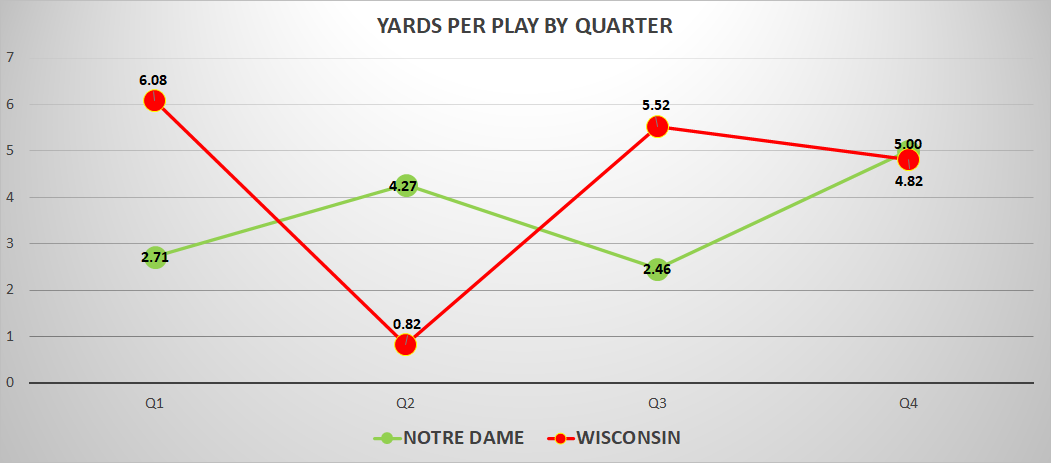
Finally some garbage time! However, it only began per SP+ definitions once the Irish scored their final touchdown to lead by more than 22 in the 4th quarter, so only the final Wisconsin possession was thrown out.
Confused? Check out this handy advanced stats glossary here or reach out in the comments.
Explosiveness
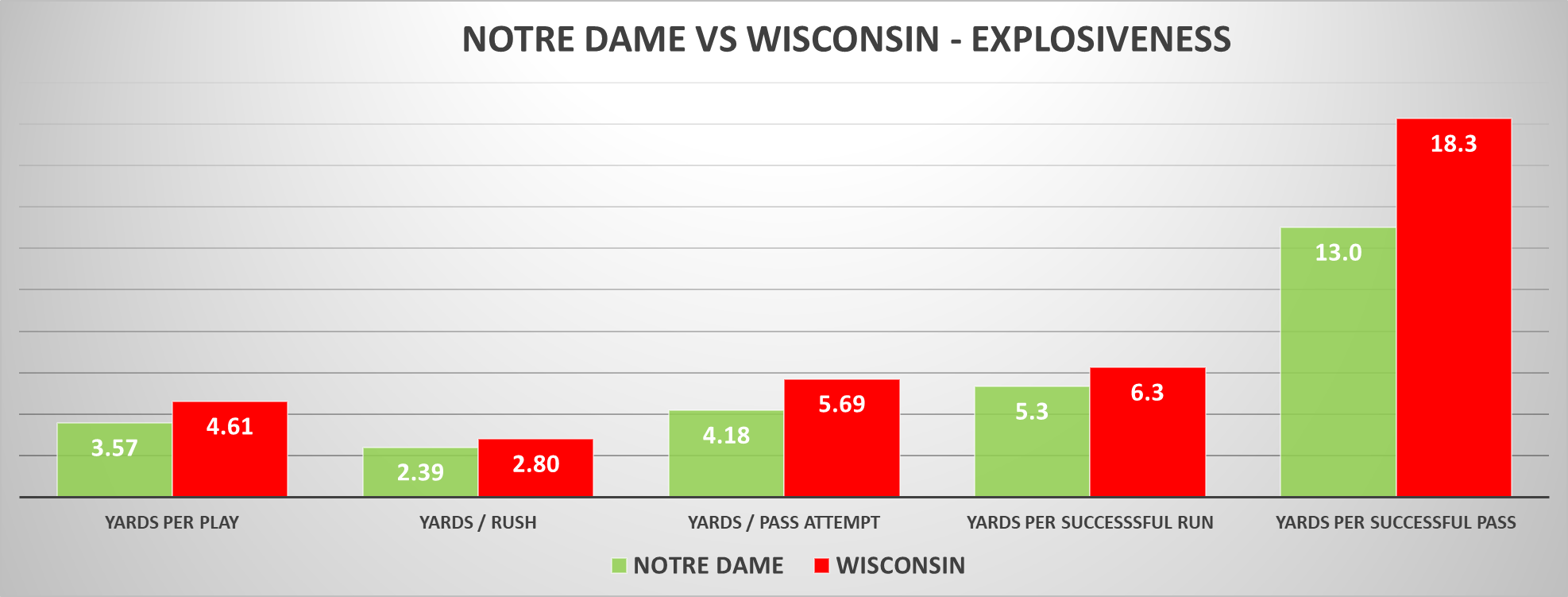
Spoiler alert: these breakdowns will be nowhere near as fun as the result of the game and gaudy final score. The core, repeatable stat categories reflect the first 50 or so minutes of game time – an ugly, even, defensive battle. You do not need advanced stats to recognize this, yet somehow every national recap has turned into a story of brave truth-telling about how actually this wasn’t a 28-beatdown. Wisconsin outgained the Irish in yards per play by a healthy margin but neither team was able to move the ball consistently, especially on the ground where both finished under three yards per carry. Wisconsin surprisingly held the big-play edge through the air (especially since the long Chez Mellusi shovel-pass counts as a pass), but was forced to lean on their inefficient aerial attack much more than usual, passing on 60% of offensive plays.
For a second straight week, Marcus Freeman’s defense made a Big Ten opponent earn their points, limiting long explosive plays and forcing the Badgers into passing downs where Mertz struggled. The prototypical UW rushing attack is a little like Navy in their intent to run for at least 4-5 yards per carry on early downs and keep things on schedule. As ISD’s Jamie Uyeyama pointed out, the Irish held the Badgers to 1.8 yards per carry on 1st down and 0.8 yards per play on 3rd down. The vaunted Wisconsin rushing attack had a long run of ten yards, and the long passing plays came from a shovel pass (with a tough missed tackle) and making Mertz hit a deep ball to a second-string tight end.
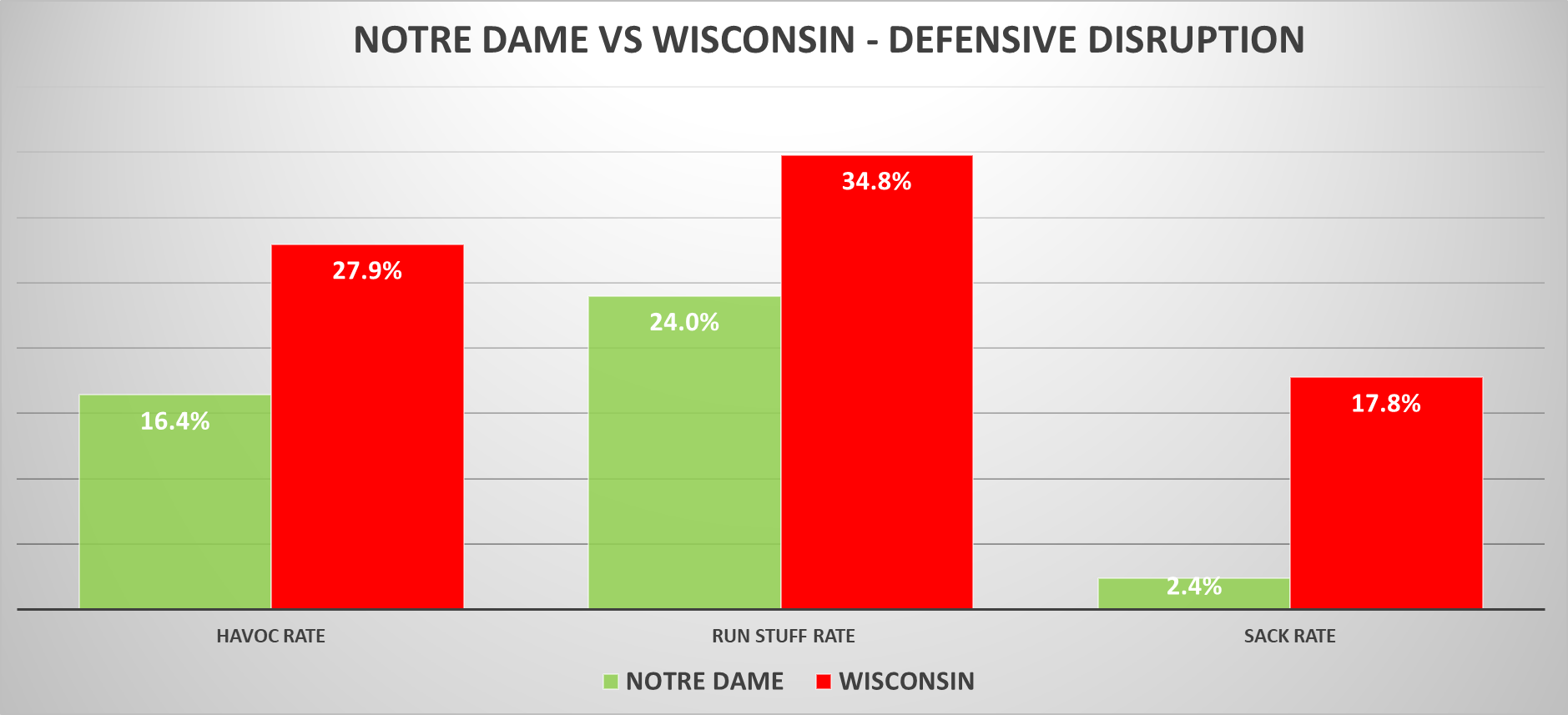
The Notre Dame offense was able to cobble together scoring chances (with major assists from the defense) on 5 of 13 drives despite the very good UW defense constantly creating negative plays. No one expected much from the Irish rushing attack, but they were stuffed constantly with 8 of 23 runs going for no gain or negative yards. Pass protection wasn’t any better, and in total, the ND offense lost 61 yards in negative plays. Despite the big win, the ominous question of “How do you produce offense with this offensive line?” looms like a dark cloud over Tommy Rees.
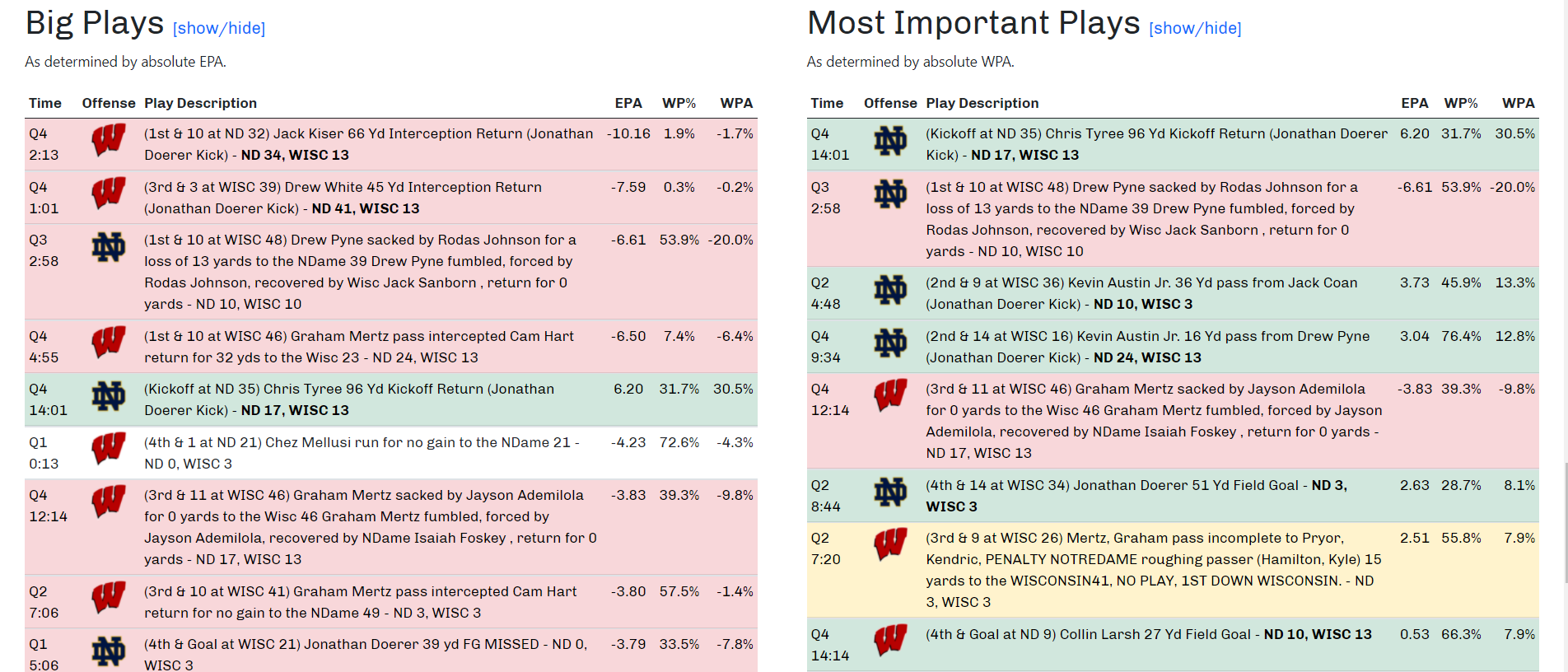
It’s fitting that the most impactful plays of the game (by total EPA) were dominated by both defenses and the Tyree kickoff return touchdown. The first Kevin Austin receiving touchdown registers as the most impactful positive play by either offense and is all the way down at the 10th biggest in the game in terms of EPA on a single play.
Efficiency
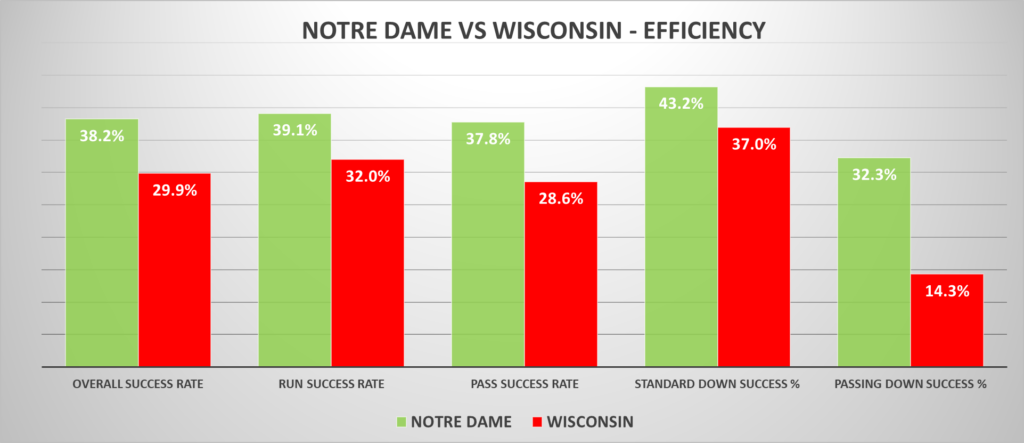
Notre Dame was able to to MacGyver together close to average offensive efficiency with some streaky passing success and a workmanlike ground game. Getting to a near-40% success rate rushing while averaging 2.4 yards per carry is some statistical voodoo – it featured a couple of 2-yard successes on 3rd/4th and 1 (a Kyren run and Coan sneak), and a bunch of 5-6 yard gains on first down runs when backs weren’t stuffed.
Dear LBers:
Do yourself a favor and #BuckleYourJunk when blitzing RB 23 @Kyrenwilliams23. You’re welcome. #GoIrish pic.twitter.com/sJEfyiPL7r
— Aaron Taylor (@AaronTaylorCFB) September 27, 2021
It deserves mentioning that this was another epic performance by Williams in blitz pickup, rivaling last year’s Clemson game that earned national hype. This season surely hasn’t gone as expected for the junior with NFL aspirations, as he constantly tries to break tackles at or behind the line of scrimmage, but he just keeps doing the dirty work, setting the tone as a captain, and plugging away every play.
With Coan going out with an ankle injury, we saw our first Drew Pyne appearance since his single pass attempt in the Rose Bowl against Alabama. While it was a really small sample size, Pyne moved a bit more smoothly in the pocket (and just a bit – he did take a sack trying to escape running into his own linemen) and delivered some accurate medium range passes into traffic with touch and some zip. His performance was pretty favorable compared to Coan’s in just a few possessions:

Good thing no one will wildly extrapolate those numbers to argue who should start! At this point Coan, Pyne, and Buchner are all offering varying degrees of pocket passing, mobility, and running threats. It’s hard to know which can be more successful with the state of the offensive line, other than that the QB has their work cut out for them. A snapshot of Notre Dame’s OL advanced stats paints a very grim picture through four games:
- Rushing Success Rate: 123rd
- Power Run Success: 112th
- Line Yards: 127th
- Run Stuff Rate: 130th!
- Havoc Allowed: 121st
- Sack Rate Allowed: 122nd
It’s a minor miracle the Irish are 63rd nationally in offensive points per drive despite those struggles. Is it sustainable? Unlikely, but top end talent capable of breaking big gains like Williams, Tyree, Mayer, Austin, and Lenzy make a compelling case. It’s a thin margin for error offensively, and leaves Notre Dame vulnerable if the elements or a bad day leave the offense unable to manufacture big plays.
Adding to that margin of error, however, is the Irish defense. Even throughout the struggles against FSU and Toledo the defense was outstanding on 90+% of plays, just the few that didn’t go right were all busting for 60+ yard gains and touchdowns. Now with some time and adjustments, that small percentage of bad plays hasn’t been as costly, and defenses have largely been unable to put together long drives against the ND front.
Notre Dame is up to 18th in rushing success allowed, 6th in preventing opponent power runs, 15h in stuff rate, and 9th in standard down success allowed (with passing success rates wildly improving every week). The Badgers only averaged 6.6 yards to gain on 3rd downs (compared to 8.4 for the Irish) but were just 1-for-14, and had a 14% success rate on passing downs. Not all opposing QBs will go full Mertz, but that feels like a repeatable formula – making the stops and keeping things in front to ensure offenses have to face and convert many 3rd downs, knowing ND can be very effective in those situations.
Finishing Drives, Field Position, & Turnovers
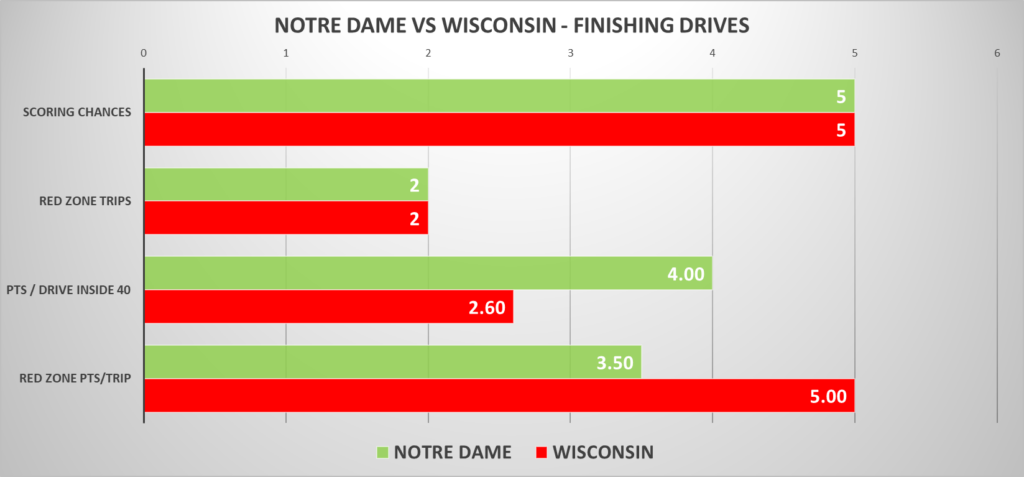
Scoring chances for each offense were even, and Notre Dame’s special teams and defense would have been in the mix with three. Again situationally the Irish defense was strong, getting a critical 4th down stop to avoid an early deficit in the 1st quarter and holding the Badgers to a bad, long field goal attempt late in a two-score game.
No one should make sweeping conclusions based on nine red zone visits and Notre Dame settling for five touchdowns (81st in points per red zone trip). However, given the bigger sample we have of running and passing results, it feels safe to say the Irish should avoid an old-school running mentality close to the goal line and continue to look for one-on-one opportunities for Mayer and the wide receivers.

From the box score, Notre Dame benefitted from a ton of turnover luck. While the fumbles meet the 50/50 expectation of losses versus recoveries for each team, there were close to an even number of passes defended, yet the Irish snagged four interceptions versus none for the Badgers.
There’s luck involved there, to be sure, but the final two interceptions (and points), while fun, weren’t necessary to secure the win. For the season Notre Dame’s turnover luck has been pretty good – they’ve broken up 6.25 passes per game, tied for 7th in FBS, and converted 36% of them into interceptions (average is 22%). Meanwhile, opponents have only intercepted 11% of Irish passes defensed, and yikes do we not need additional turnovers for the offense.




Okay, so here’s why Pyne should start….
I’m only kidding guys (well, mostly).
I could stand to hear it. In theory Pyne should be able to provide a combination of elements that Pyne/Buchner aren’t bringing to the table at the moment. Quick release, more mobile, should take less sacks and have fewer drives be DOA when Coan takes a sack on 1st or 2nd down. Better command of the offense and no hamstring issues like Buchner.
Then again, if you don’t have deep shots and don’t have a line that can get a push, that might be a mix that catches up with them and gets ugly in a hurry.
Two things in Coan’s favor:
1. He doesn’t turn the ball over. Despite getting pressured and hit like crazy, he has a 9:2 TD:INT ratio. This is quietly a huge, huge deal, I think. If we’re going to essentially ask the defense to win every game, our offense absolutely cannot turn the ball over.
2. Whoever is at QB is going to get hit an awful lot, even if they’re mobile — QB runs end in tackles, after all. We know Coan can take the hits, for the most part. Not so clear with Buchner and Pyne.
He dislocated his finger against Purdue and had to leave the Wisconsin game because he got hurt.
If you’re mobile, you can run out of bounds. Or, you can throw while running. Or, throw it away while running. Or, elude everyone and do a TD. Or, after running a few times, hand it off to a guy who is much better suited to running and getting hit.
I get that Coan is frustrating, especially with walking into sacks and not throwing the ball away. And I do think we should use Buchner/Pyne every third or fourth drive because they open up the running game. But let’s be careful here — trying to do a major QB switch while the OL is still, uh, “growing” is dangerous. Particularly when either QB we’d be switching to is inexperienced, and Pyne is tiny.
Also — turnovers, turnovers, turnovers. Did I mention turnovers? Turnovers.
Let the OL line hit puberty, and then bring back the immobile QB. Also, not fair to tout Coan’s TD:INT ratio – he could have been getting ready to throw an INT on each of his 19(!) sacks.
…but then he didn’t. So I don’t know why we’d concern ourselves with hypothetical turnovers. How is it not fair to tout what has actually happened on the field?
What if the OL doesn’t hit puberty this year?
Holds true if Coan is back there or Pyne/Buchner. But one of those 3 QBs is significantly worse at eluding pressure brought on by a “growing” line.
(Also my INT comment was 70% in jest)
I got you. And it’s obvious why we run the ball better when Buchner/Pyne is in — it gives the defense one more player to account for, and they can’t necessarily bring the ends flying at the QB with reckless abandon.
To be totally clear, I’m not a huge Coan advocate. In fact, I don’t really get why we picked a slow, immobile pocket passer out of the transfer portal with this OL. I’m just trying to be careful with what we’re wishing for, especially at 4-0.
Honestly, if/when ND loses a game, I wouldn’t hate it be to Cincinnati. 100% here for a G5 team getting into the 4-team playoff at some point.
Also, there’s a 3.3 to 5.6% chance this is a repeat of 2012 and ND goes undefeated with good defense and a mediocre offense. I’d rather not see ND get pantsed by Alabama again. Finish 11-1 or 10-2, beat an Iowa/Arkansas/Ok St/Michigan level team in the Peach Bowl and finish in the Top 10. Get the elusive Big Bowl Win™.
Points for Iowa == Michigan.
By that logic he could have thrown 19 TDs and have a 28:2 TD:INT rate if it wasn’t for the offensive line folding like a cheap table
No, don’t be an idiot.
Yes, I literally think he was going to throw 19 more TDs on every play he got sacked, you got me
Good.
Also, 2 of his sacks later resulted in TDs, so your math doesn’t hold.
He would have thrown a double TD
Coan’s sacks leads to punts, like the first series of the Wisconsin game where they got the ball at the ND 45. It is a great point that Coan doesn’t turn it over, but in the field position game with Bramblett being inconsistent, a punt isn’t much better than a turnover and Coan steers them into a lot of punts.
I’ve shared this stat before, but it’s worth repeating just how much Coan is turning pressures into sacks. That’s more than just “frustrating” it’s putting a big cap on this offense right now.
That said, I think your point about not making a major change (against the highest ranked team ND will play all season) is a viable one. If Coan’s ankle is healthy enough, he probably should start. But if he’s taking sacks and isn’t operating the offense, Pyne is worth a look. And if Pyne plays like he did last week, he shouldn’t really come out of the game until he does something to merit it.
Ehhh. Coan could have easily had two picks in his 2-plus quarters of work, one erased by a dodgy PI penalty and the other cold dropped by a Badger defender on the opening drive. He’s been…fortunate on that front.
Whooops, sorry for throwing this bomb and walking away!
Feature request:
I’d love it if someone who actually knows the game did a breakdown on success/opportunity from various offensive formations. Going into last week’s game, I was hoping to see a spread attack. The “eyeball test” from seemed to confirm that the 2021 Notre Dame football club is a not a running team. It was hard to watch the Wisconsin defensive front eviscerate the ND O-line from traditional pro style or power sets, but whenever our boys went 5-wide, it felt like 2+ open receivers on every damn down. The offensive numbers don’t tell a huge story, but it FELT like they were dominating these plays.
I think ND has too much talent outside for defenses not to play nickel. Austin and Lenzy can both get separation on vertical routes, making it dangerous to ever creep safeties into the box. This should create enough space in the middle for screens and crossing routes, while always giving Coan/Pyne/Buchner a hot read when the O-line misses an assignment or get overwhelmed by a blitz. Williams and Tyree are both capable receivers who could be motioned into the backfield whenever the defense compensates for the speed attack (plus Lenzy and Davis can grab the ball on jet sweeps).
Am I dramatically oversimplifying something? Clearly, Rees is getting more comfortable with these spread sets as the season progresses. But why wouldn’t they just live in that formation? Is there any reason they cannot play a quick-to-the-line-of scrimmage style that prevents defensive substitutions, and just exploit whatever is working?
This is what I’ve been thinking for a few weeks now. It seems painfully obvious to me that a no-huddle 0/1 back base offense would be successful, which can only mean that ND would finish the season 4-8 if they implemented it.
This has some nice data from the Wisconsin game:
–Almost all designed rushes last week were coming in 12 personnel (1 RB, 2 TE, 2WR). Even then, they aren’t getting anywhere.
–They actually performed best in yards/play and 1st downs passing from 12 as well, even more than 4WR. ND did almost nothing passing in 11 (1RB, 1TE, 3 WR), which might be situational for down and distance but doesn’t good.
–They did OK passing from 00 (0 RB, 5WR…Which I think is actually TE/RB’s split out like WR for this team)
From this, my takeaway is the path for success still is 2 TE’s. That way you can have Takacs/Alt in as an extra blocker and Mayer going out on a route. And have the threat of running.
If Buchner can play, using extra WR to spread more and then run might be the only path to actually getting somewhere on the ground on keepers or the read.
Ok, that’s great. Run the numbers again, but only use the ones that prove ND_Joe’s point above.
First off, thanks for the response. That dataset is awesome as well. With this type of engagement, I’m just gonna keep my premium membership on auto-renew — someone from management, please let me know when my credit card expires).
I think the dataset of 8 plays in 00 might be too small to draw any conclusions; a single drop or errant throw can really skew a stat on such a small base. (also pretty sure Wisconsin was the first game to get more than a couple plays with the look, but not good enough at ‘puters to confirm it with the source data)
My argument is that it would be more effective as the base formation instead of an occasional changeup. It allows a quick-to-the-line strategy, which gives a huge advantage to the offense if they see a mismatch in personnel. Agreed that with ND, 00 actually includes at least 1 TE and 1 RB split out, which I think would make it even deadlier if used constantly. Defensive coordinators would have to decide in advance whether to use safeties/nickels or linebackers to handle those guys. Short passes pull defenses forward, opening up big play opportunities over the top. Deep passes pull the secondary away from the line of scrimmage, opening up quick strike opportunities in the flat.
They could stay 5-wide for entire drives if it’s working, but there’s also nothing stopping them from motioning into a 11 or 21 with 15 seconds left on the play clock for short yardage plays. They’d probably have to give up 12 though, since Mayer is the only credible receiving threat among TEs.
The biggest reason for the 00 is that it neutralizes the main weakness of the ND offense. The young line would be working against 5 and 6 man boxes all day and almost exclusively in pass protection. This dramatically simplifies their blocking assignments; the spread requires very little pulling, double teaming, or trying to get to the second level. The pre-snap read for the quarterback is more about finding the mismatch than about counting bodies and locations in the box. There are also quick outlets to the boundary or crossing routes to get rid of the ball on blitzes.
The Irish cannot run the ball, so it’s not the “safe” choice we want it to be. Short passes are better than getting stuffed. Incomplete passes are better than sacks.
Kinda seems like maybe YOU should be writing the feature you just requested?
No, I’m spent. That was the full extent of my football talking skills, and I’m quite confident it would not stand up to expert cross-examination!
I love this thread!!!
I think the “00” look of 5wr would be best served with the following skill players as a base: lenzy, austin, tyree, William’s, Mayer. This is 21 personnel, but has the ability to go 00. I believe the advantage here is you can go high tempo spread, and have access from a plethora of formations. This forces the defenses to stay in whatever package they have on the field, i.e. subs are only allowed in up tempo if the offense subs. If your offense already has 2 rb/slot types and a good TE, then theres extreme flexibility in formations, and the defense is basically stuck in whatever they put out there.
Some counters to 5wr, while yes it does spread things out, you’ve committed to 5 blockers only, no 6th blocker. I’d even argue at this point that kyren is a better pass blocker than some of the OL up front, so that’s a massive tradeoff. I think it can work, provided there are tunnel screens and bubbles to compensate; 5 yards is 5 yards and I dont care if comes from 12 personnel up the gut or a quick bubble to the flat.
I do think rees is making changes and doing a decent job of playing this deck of cards, but my biggest concern is personnel predictability for run/pass. Lots of 12 personnel runs, and that stuff definitely resonates in a LB heads pre-snap. Some 11 or 10 personnel quick hitters are required just to make the presnap option less predictable, and honestly, how much worse could the run game be with less TE’s?
This circles back to my last week comments regarding the art Briles baylor offense, which is a summation of everything in this thread.
In short, I do like the 5wr sets, but there is added liability in that you need some oline play to stretch the field with it due to lack of extra blockers.
Having only 5 or 6 in the box and spreading teams out doesn’t make it easier on the OL necessarily. It makes it easier to identify where blitzers are coming from b/c the defense is more spread out, but our OL has struggled blocking even when the other team isn’t blitzing.
I would argue that the task is not so much to make it easier, but to make it simpler. You can’t scheme your way out of a guy getting beat 1-on-1, but you CAN design a play so he at least knows exactly what he has to accomplish. Thinning out the box and passing on 80% of downs should help with that goal.
Generally speaking, the pass blocking is actually not bad (despite the extreme number of sacks). The bigger issue has been creating a lane for the tailbacks. This whole discussion presupposes that the only reason ND would run between the tackles is in scenarios where the defensive personnel would be overmatched.
They could always pass out of a 21 or 11 with the same guys on the field, just to mix up the looks and make runs less obvious.
OK, that makes sense. I am more on the side that our OL just doesn’t have a combination of talent and experience. We have experience on the right side with Lugg and Madden but not a ton of physical athleticism or talent there.
Then on the left we have decent talent with Carmody/Baker but they have no experience and Correll has I think pretty good talent and experience but is playing out of position.
If I had to design an offense I would go with the types of concepts you are describing, I’m just not sure that our OL is going to be anything but average this year regardless of what concepts or scheme we use.
Thanks for the analysis as always! With the team being 4 games in now is there more data on how each of the o-linemen are performing? Are 1 or 2 guys the weak links while everyone else is playing at a decent level? Or is there below average performance across the whole line?
I wouldn’t mind seeing this too. I’ve heard some analysis (maybe Prister?) saying Lugg is playing better over the last few games…But it’s really difficult to tell if that’s true, and if true just how meaningful it actually is. I mean they have run right for like that 4th+2 and some other little gains. Not much, but some signs of life, at least.
Kelly put some cold water today on Fisher coming back this season, so I think the OL is just in deep trouble. 4 LT’s in 4 games is a circus, though. Ideally Carmody can provide a decent level of play, it does seem to my untrained eye that Baker at LT is the current weakest link by far over the past few weeks. So I guess maybe you hope for more competency if Carmody upgrades LT to at least beyond “not a turnstile” and the timeshare at LG freshens up the mix?
Hope isn’t a great strategy but at this point of the game, not really sure what else they could really do. Getting Buchner back though will help the run game. Probably not the OL that much, but maybe they can get some confidence if they stop getting completely caved in.
I agree, based on the casual eye test Baker seemed like a weak link. It also seems like the coaches might think that LG is an issue as well, with Kristofic getting more reps there
Hope is the only strategy we have left.